- Call Us: +9607778700
- info@alafehiretreat.com

Fuvahmulah, the atoll island, peaks out of the deep blue in solitude, a green speck surfacing from a vast ocean just south to the equator. The seas, known for their omnipresent ferocity, rises in waves of oceanic midnight blue, pulsating and crashing over the edge of the island’s reef. Frothing like a body of possessed water, it surrenders onto the reef flats, oceanic hues turning to a turquoise blue before disintegrating at the ragged edges of the eastern reef. On the western edge, the waters pass through shallow waters vibrantly alive with blotches of coral and sea life until it gradually merges with the thresholds of an endless white sandy beach.
The island is said to have been settled by seafarers who must have braved the immense powers of the seas to be able to come ashore and find the idyllic refuge. Two hundred years ago, Fuvahmulah had a natural harbour-like lagoon seeping into the atoll ring through a channel at its southern tip. Over the years the opening to the lagoon closed naturally. The natural mort-like structure of the island gave protection to the vegetation growing along the rim of the lagoon. The trees and plants species on the fringes gradually made their ways inwards through the lagoon, merging with pure rainwater, forming two freshwater lakes nestled within the sunlit abundance of wet taro fields and mangrove species.
This high ridged concave land of green protected from the pulsating tempest of the seas is known for its abundance of all types of captivating flora and fauna, making it one of a kind here in the Maldives. The diverse and rich biodiversity of the island, both on land, and in the marine ecosystems surrounding it, has led to Fuvahmulah being declared a UNESCO Biosphere reserve in 2020. The thick forested, winding passageways of the island have been made by generations of settlers who came from the seas to make this island their home. The esoteric lives they lived among a thriving ecosystem and the stories they told, form the unique identity of this island and atoll named Fuvahmulah.
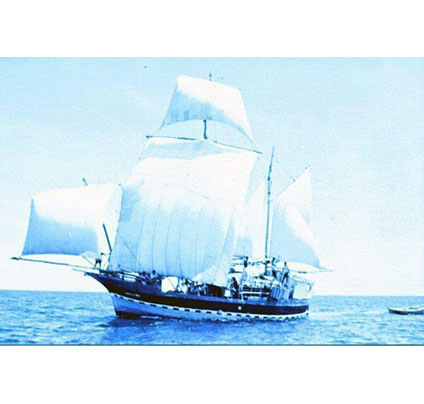
The island’s name literally means “areca nut island”in Dhivehi language. “Fuvah” is the name for areca nuts, and “mulah” is a way of referring to an island. It is the third largest inhabited island in the Maldives with an area of 484 hectares and with a population of about 14,000 people who speak a unique dialect of the island.
Fuvahmulah’s enthralling natural atmosphere and its people's long held affinity to the tradition of understanding the elements of existence are deeply interlaced with the daily lives on the island. The island’s traditional learning system includes teachings on herbal medicine, navigation, and metrology, as well as written works of an esoteric nature of astrology and magic. Fishing and farming have been the main activities of the economy until the recent introduction of tourism to the atoll.
Being located in the Indian ocean’s equatorial seafaring route meant that Fuvahmulah, like the other southern atolls, had a well established direct trading tradition with the neighbouring countries up until the middle of the twentieth century. The southwest monsoon winds took the locally built sailboats northwards, to the southern shores of Ceylon, where they sold their produce and engaged in enterprising encounters, as the native rhyme below expounds. The boats set sail to return home with the winds of the northeast monsoon, loaded with goods and riches for families and fellow islanders waiting in anticipation.
Let us set sail on the odi, it's the first fortnight of September,
the prices are fair in Ceylon, and we can sell our fish and sweets
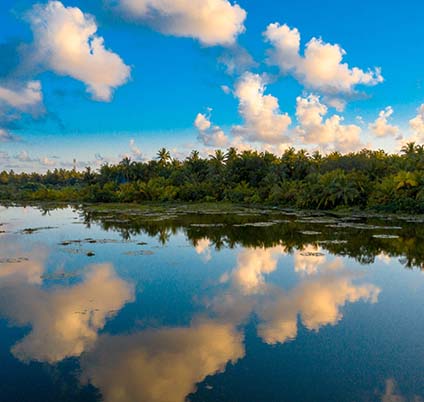
The “rashoveshi” translated as “island environment” - originally written by the late Ibrahim Fikri Didi of Fuvahmulah (commonly referred to as Kariyya Kalhuthuththu Didi) - is a composition that captures the essence of the island, its geography, landmarks, memories, and historical accounts. Composed in 116 verses, the rashoveshi describes a bird’s eye view of the island as its verses navigate through locations on the windswept coastlines of the island, changes of the seasons, historical remnants of the island’s ancient Buddhist tradition, knowledge of their traditional medicinal system, the way of life in the island, its birds, and its crops, and dwells on stories of deep sea legends and songs of the forest.
We have compiled below a list of notable features and concepts of Fuvahmulah, as well as poetry found in the Rashoveshi and in other commentaries written about the island.

There is no lagoon around the island, but a reef flat that cuts off at the edge with a sharp drop into the deep blues of the sea. In the old days, it was extremely dangerous to reach the island’s shore by ship. There are eight man-made channels (neru or elhe’) opened around the island fringe to gain access by boat. There is a fanno on the beach in the direction of each channel - a fanno is a communal point among the shade of coconut palms where the island’s interior pathways meet the breezy vista of the ocean. This is the point where people come together in anticipation of arrival of a vessel, to observe weather patterns, or to catch up with neighbourhood friends as they wind down for the day with the sun setting in the horizon. The names given to each of these channels and fanno - such as Rasgefanno, Bodofanno, Anbul, Maaneyre and Badahalfanno - elucidate the historical view about the events that happened around each point and the people who inhabit the area.
By the fannu of Gen Miskiy,
the people make their alms and break their fasts.
Betel leaves and areca nuts,
young flesh of coconuts, and trays full of delicacies,
garlands of Indian lavender and pandanus flowers,
fill the air in the late afternoon light…
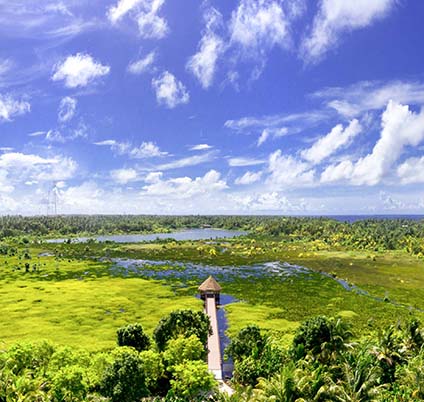
We, Fuvahmulans take immense pride in our island home. It is one of the richest natural ecosystems in all of Maldives - the largest producers of Maldivian mangoes and taro. The island’s farms, nutrient-rich soil and marshlands in the backyards of homes produce varieties of fruits and vegetables; guavas, pineapples, bananas, pomegranates, breadfruits, papayas, coconuts, brinjals, pumpkins and many more are eaten fresh, daily. It is one of the most self sustaining island communities across the archipelago.
The two protected freshwater lakes - Dhandimagi Kilhi and Bandaara Kilhi - as well as the surrounding swamps, marshy areas, jambul groves, dense groups of mature Alexandrian laurel (funa) trees, and endless spreads of taro and kan-kun fields extending outwards from these water sources give Fuvahmulah its distinct identity. Taking a mud bath among the banks of the lakes and swimming in its freshwaters are still favourite activities of leisure and therapeutic healing for children and adults. Treading the meandering pathways on a bicycle could be the best method to encounter the quiet lives that inhabit these wild and sheltered, moss covered habitats. Sitting quietly at the banks of a backyard pond for a minute will most likely make you aware of a rustling presence of a discerning moorhen - valikukulhu - dipping in and out of the water, dipping in and out of the water, foraging around nonchalantly.
Most island homes are built with modern amenities but women and men still collect firewood in the deep funa groves for types of traditional cooking such as smoking tuna fish. Dense bouts of vegetation spurt out like wild wet sanctuaries between scattered homes. Wandering through narrow alleys of neighbourhoods often lead to dead ends of roads covered in white gravel or to an unexpected encounter with the afternoon light in a sleepy backyard, where a mother quietly rocks a swing lulling a baby to sleep, with melodic prayers and songs of faraway seabirds.
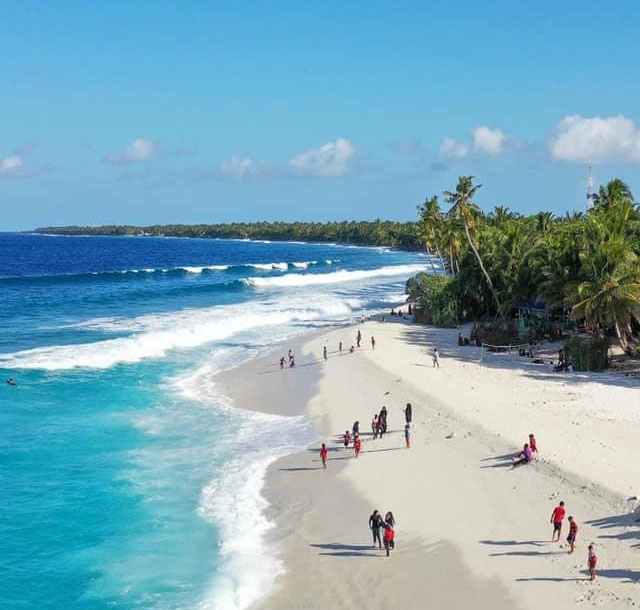
Brightness of its colour white,
like the brilliance of diamonds,
the smooth luminous sand of the thoondu
makes me happy at its sight.
The thoondu beach of Fuvahmulah is one of a kind. The seasonal temperament and movement of the vast pebble sands of thoondu reflect a crucial attribute of the Fuvahmulan geomorphological identity. The lively body of white coral pebble sands polished to smoothness by the vigour of the sea waves are a perpetual playground of amusement, illuminating the senses of children and adults alike.
Everyone gathers at the Thoondu for picnics and celebration with the formation of the Bissaaveli - a natural phenomenon that occurs with the movement of portions of the sand on the beach towards the reef, resulting in the creation of a temporary lagoon cushioned by pebble sands and shore.
The annual sighting of the new moon of Ramazan is also celebrated on these sands. On the day before the first day of the fasting month, from afternoon onwards, people from all districts of the island gather under the shades of the shoreline trees from afternoon onwards. Carrying on with the old age tradition, we celebrate this day amidst the presence and glory of nature’s elements that have blessed the island in its abundance for millennia; alternating between dips in the wild sea waves breaking on the thoondu sand and tasting homemade steamed coconut and jaggery patties, smoked fish, boiled taro and breadfruit, pandan fragranced rice pudding, and the many delicacies prepared according to age old recipes passed on from generations. And every year, the vast night sky and the new moon, yet to be visible to the human eye, bear witness to this harmonious spectacle of the people who have coexisted among this land and its seas for generations.

Remains of the islands’ Buddhist ancestry are found scattered around the Maldives. The Vasho-Veu, an ancient circular bath with stone-steps skilfully built out of porites coral stone, sits still, now veiled by the moss of time in an old mosque compound. Ruins of a Buddhist stupa known as the Fuvahmulaku Havitta are still found at the northeast of Fuvahmulah, in the location of what was probably an ancient monastery. A stupa is a Sanskrit word meaning "heap". It is usually a hemispherical structure - a dome shaped silent abode for meditation. The Fuvahmulah Rashoveshi in its verses refers to the ancient Havitta and relics found inside in past explorations.
The havitta was looked upon, a portion of it dug open,
two or three containers made of stone were found,
inside them were golden tins, haikals, and lamps,
smaller artefacts of gold, bronze and copper.
Witnessed by the eyes of the people, big and small from each ward,
Chants of praise sung in rhapsody, for the leader of this esteemed endeavour,
who would duly transfer to Male’ the capital
the relics of Fuvahmulah found inside the ancient Havitta mound.
These verses, adapted from its original Dhivehi text, reflect on the circumstances relating to the sites and artefacts of our ancient heritage. The sites have been covered with sand after the Maldive islands converted to Islam and the temple structures in the adjoining grounds converted to mosques. The elegant coral stone mosque, Gen Miskiy, with its neatly structured water well and surrounding graveyard, is said to be one of the oldest mosques in Fuvahmulah, adapted as such after the conversion to Islam. As cited in the Rashoveshi, the mosque yard and adjacent shores were used by the islanders as holy sites for making alms and bestowments to ancestors. Prayers were recited and incense sticks burnt to lull the atmosphere while the people shared a feast of local delicacies and made acquaintances, strengthening bonds with each other and their surroundings. The tradition of alms giving and incense-burning recitals were stopped since the early nineteen eighties, but the annual feasts continue by the thoondu beach just across the compounds of the mosque, the former temple site.
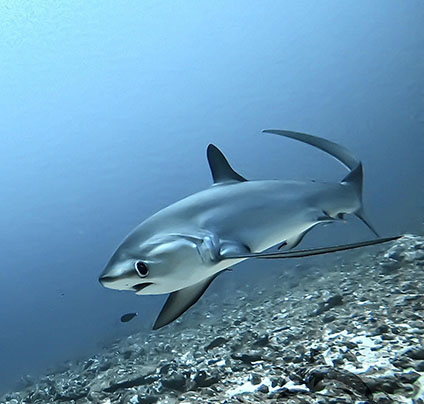
Stories and folklore about spirits of the deep sea are engraved in the Maldivian psyche. The mighty nature of the ocean humbles the island inhabitant. It takes a well learned Maldivian seafarer to navigate among the dynamic depths and mesmerising shallows of seascapes surrounding an island - named faru, falhu, gaa, haa, giri, thila, kandu olhi, and maa kandu - depending on the depth and nature of the half visible geographical formations thriving beneath. The sea is the source of the people’s main dietary protein and sea travel is a part of daily island life. And yet the sea remains a mysterious body, immensely vast; and deeply captivating for anyone who dares to explore what lies beneath its vivid gradients of blue.
Fuvahmulah’s unique topography - its submerged reef extending deep towards the ocean - as well as its isolated location makes it one of the best diving destinations in the world. The steep rock-like atoll structure of the island breeds vibrant coral reefs of healthy porites and acropora fringing at its peripheries. Trevallies, barracudas, and large schools of fish glide with the continuous ocean drifts while smaller fish graze on the reef flats, creating the vision of a field of rainbow hued butterflies.
The surrounding outer atoll currents bring in magnificent pelagic creatures - bizarre-looking thresher sharks, large numbers of tiger sharks, silver tips, grey reefs, the occasional hammerheads as well as gigantic whale sharks - to feed on the island’s healthy reef ecosystem. Oceanic manta rays use the reef for cleaning and mating, most commonly around March to May every year. The oceanic temperatures remain warm throughout the year - usually at twenty seven degrees Celsius.

Kattelhi is the Fuvahmulan name for a deep sea fish residing along continental slopes and oceanic islands. It is called Promethichthys prometheus in English and belongs to the snake mackerel species.
The kattelhi is considered a local delicacy in Fuvahmulah, and the island is one of the few locations where this deep sea fish is found in the Maldives. It is believed that this species of fish migrate to midwater at night to feed on fish, cephalopods and crustaceans . Hence, Kattelhi is usually caught at night and is enjoyed freshly cooked in a broth as part of an exciting and impromptu late night meal celebration, with servings of boiled taro, chilli and lime on the sides.
Stories about the kattelhi are told in the island’s folklore and tradition; a part of the island’s unique intangible identity.

Taste spurts from the soil,
like gold, the coconut tree’s reap;
Tuberous roots growing from small bulbs,
the taro fields are enough to keep our stomachs full.
As told in the verses of the Fuvahmulah Rashoveshi, the people of the island have always depended on the abundance of plant species for our livelihood and well being. The island has had a long tradition in healing its people using traditional herbal recipes originating from indigenous methods and those acquired from the relationships built along the trade routes of the Indian ocean. Huvandhu is one such modern local brand that produces tamanu oil and other plant based oils and medicines from native growth. Local raw materials used in production include funa nuts (Alexandrian laurel), lemon grass, moringa leaves, and noni plants (Morinda citrifolia), to name a few. These herbal medicines along with other other coconut and breadfruit based delicacies, aromatic spices, fish paste, fresh fruit and vegetables are found in a small local market located at the western end of Ghaazee road.
Like other Maldivian islanders, Fuvahmulans’ heritage and traditions are deeply rooted in stories about wild coconut groves’ - ruggado - that grow along shorelines and breezy fanno areas. Coconuts serve multiple purposes in the daily lives of the islanders; their dried palm leaves are used for thoshali roofing, fencing and weaving baskets (mudeyshi). The chips of its wood as well as husks of dried coconuts are burnt for firewood and charcoal, while its timber is used in building. The fruit - the coconut - is used in all stages from growth to maturity. Its sweet nutritious pulp is eaten raw and used for an endless variety of local recipes, curries, and savoury and sweet delicacies. The water contained inside the nut in its pure state is a remedy still used in healing common ailments such as fever and dehydration. Toddy - a natural brew - is produced from the sap of the coconut palm and the world famous “virgin coconut oil” is made from the coconut’s nutty pulp.
Hence, it is not a wonder that the coconut tree, like many other elements of the island’s wilderness, hashed a strong presence in the ancient folklore that shapes the island psyche, as narrated by midwife Himitheege Haleema of Miskiy magu, Fuvahmulah, for the book “The Maldives Islanders” by Xavier Romero-Frias.
The coconut was also a symbol of new life: at childbirth, ancient Maldivians would not throw away the placenta. It was customary to place it inside the shell of an empty coconut in the kihah stage - young coconut having soft shell - with the severed top as a cap, following which it would be buried outside of the burial ground and a coconut tree would immediately be planted in the same spot. Thus, people could see along their lives the growth of the coconut palm that was planted right at the moment of their birth.
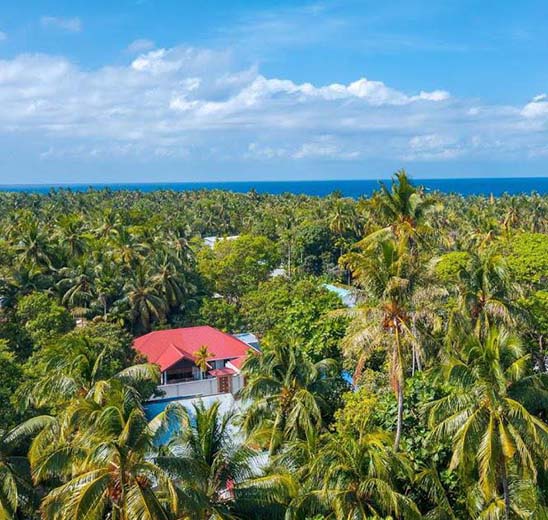
Stories and folklore about spirits of the deep sea are engraved in the Maldivian psyche. The mighty nature of the ocean humbles the island inhabitant. It takes a well learned Maldivian seafarer to navigate among the dynamic depths and mesmerising shallows of seascape surrounding an island - named faru, falhu, gaa, haa, giri, thila, kandu olhi, and maa kandu - depending on the depth and nature of half visible geographic formations thriving beneath. The sea is the source of the people’s main dietary protein and sea travel is a part of daily island life. And yet the sea remains a mystical body, deeply captivating for anyone who dares to explore what lies beneath its vivid gradients of blue.

Wanderlust Travel magazine 2014 listed Fuvahmulah Island among the nineteen secret beaches in Asia.

Fuvahmulah is famous for its mangoes, bananas, lush taro fields, and the two freshwater lakes that emanate peace and serenity.

Fuvahmulah, which has been declared a UNESCO Biosphere reserve, is an oasis of greenery which once fed its inhabitants with the produce of its fertile soil.
Cross the equator to visit Fuvahmulah, a UNESCO Biosphere reserve, and stay with us to experience our culture and distinctive customs, and to explore the depths of this precious pearl of Maldive seas, from the comfort of your private retreat in the island.
Wanderlust Travel magazine 2014 listed Fuvahmulah Island among the nineteen secret beaches in Asia. This beach, 'thoondu' in the local dialect, amazes both locals and visitors alike. A barefoot walk on this unique sand is said to be a heavenly experience for all.
Around this single island in the atoll, divers encounter a variety of pelagic species which are rare in other parts of the Maldives. Thresher, tiger, oceanic whitetip and hammerhead are some of the shark species that are often seen, while the oceanic manta ray is a delight to watch.